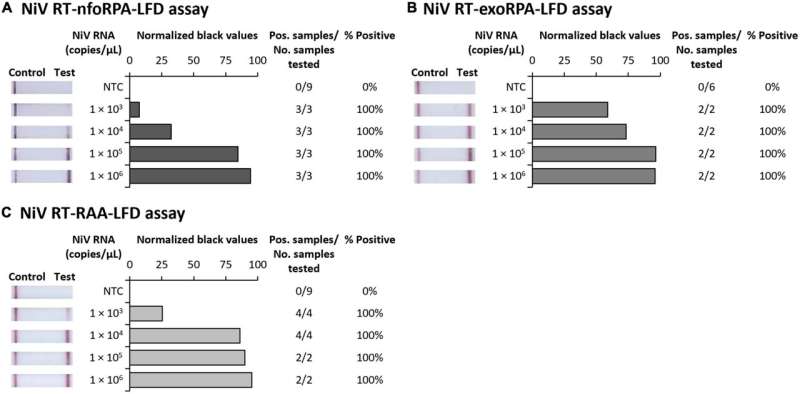This article has been reviewed according to Science X's editorial process and policies. Editors have highlighted the following attributes while ensuring the content's credibility:
fact-checked
peer-reviewed publication
proofread
Test developed for bat-borne virus in Asia

University of the Sunshine Coast-led research has developed a simple dipstick test to screen for a highly infectious, potentially deadly virus transmitted by bats to humans and pigs in Asia.
UniSC's Center for Bioinnovation worked with CSIRO's Australian Center for Disease Preparedness on the research into the Nipah virus, published in Frontiers in Microbiology.
The virus was first identified in 1999 in Malaysia, where it was associated with an outbreak of respiratory and neurological disease in pigs, with transmission to humans resulting in encephalitis (brain inflammation) and deaths.
Symptoms of the virus in humans are fever, headache, coughing, difficulty breathing and vomiting. Severe symptoms can include confusion, seizures, coma, severe respiratory distress and encephalitis. It is fatal in 40 to 75% of cases.
UniSC Associate Professor of Molecular Engineering Dr. Joanne Macdonald said, "Our test allows, for the first time, screening for the virus outside of the laboratory.
"We can do this through a novel sample preparation method that inactivates the virus in the first step of the procedure, making it safe to perform testing outside of a lab."
Postdoctoral researcher Dr. Nina Pollak, who applied the UniSC technology for Nipah virus detection, said a simple lateral flow dipstick showed a final result, similar to COVID RAT screening.
"However, it is much more sensitive than a RAT because it includes an amplification step similar to a PCR, which provides laboratory-level sensitivity but in a highly portable format," said Dr. Pollak, a UniSC Research Fellow.
Dr. Macdonald said a rapid, portable, point-of-care test for Nipah virus would be useful in rural or remote areas in Asia where outbreaks of the virus have occurred in the past, as well as areas where fruit bats, which are known to carry the virus, are found.
"Such a test would also be useful for health care workers, veterinarians, ADF personnel and other professionals who may be at risk of exposure to the virus," she said.
The Nipah virus has not yet been identified in Australia, though it is closely related to the Hendra virus which is transmitted by flying foxes to horses and humans and has caused fatalities in Queensland and New South Wales.
More information: Nina M. Pollak et al, Evaluation of three rapid low-resource molecular tests for Nipah virus, Frontiers in Microbiology (2023). DOI: 10.3389/fmicb.2022.1101914


















